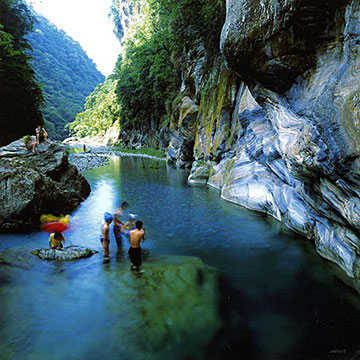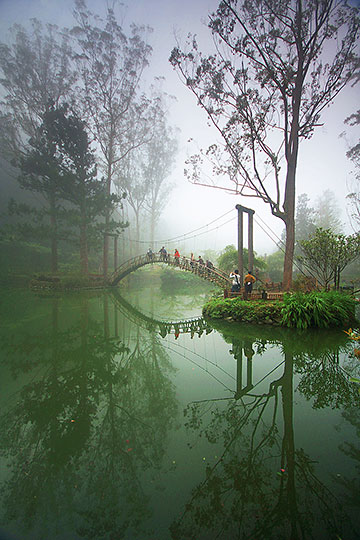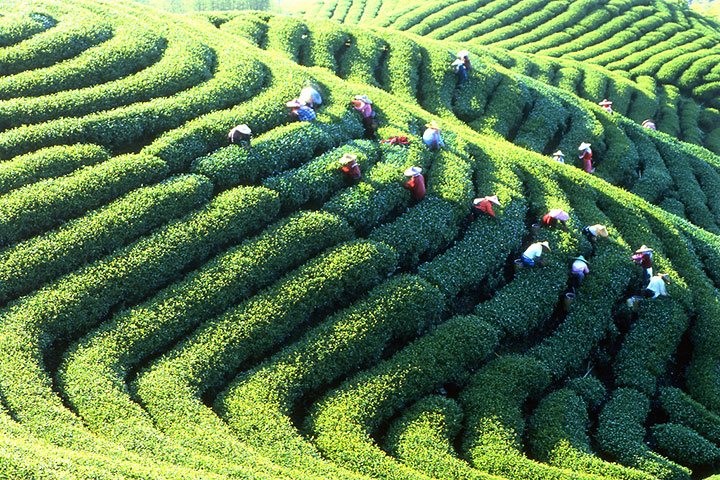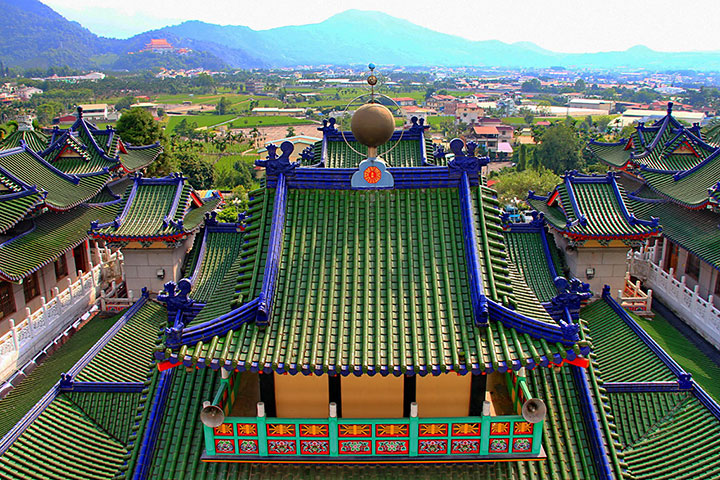          |
|
|
Nantou Nantou County lies at the geographical heart of Taiwan and is the only county that does not border the coast. If the central region is the heartland of Taiwan, Nantou is Taiwan's heart: it is the only landlocked county on the island. Nantou County occupies an area of about 4,100 square kilometers. It is home to Taiwan's highest peak, Yushan (Mt. Jade), and 41 other 3,000-plus-meter mountains that form an unbroken and undulating expanse of green. Taiwan's longest river, the Zhuoshui River, winds through the county, and the island's most beautiful lake, Sun Moon Lake, completes the county's scenic tapestry.  Taroko National Park
Taroko National ParkTaroko became a national park in 1986, including Hualien County, Nantou County and Taichung County. Taroko is famous for its spectacular mountains and marble canyons. Cliffs and canyons stretch along Liwu River. Four million years ago, the island of Taiwan was formed by the collision of plates. After millions of years of wind erosion, the marble rocks were exposed and cut by Liwu River, creating impressive grand canyons. From Qingshui to Nan Lake (Nanhu) Peak, the drop height is 3,742 meters. Such special geography has also bred special flora and fauna in this area. The waterfalls characterized Taroko National Park and the most famous ones are Baiyang Waterfall, Yindai Waterfall, Changchun Waterfall, and Lushui Waterfall. Swallow Grotto (Yanzikou) and Tunnel of Nine Turns (Jiuqudong) are the most impressive natural scenes in Taroko and the canyons here are the narrowest. Tourists can appreciate the natural beauty along the tour track. Swallows nest on the cliff, chirping and flying back forth. The Taroko monumental is designed in Chinese style and Changchun Temple is to remember those who sacrificed their lives for building the central highway.1 Sun Moon Lake  The Sun Moon Lake, located in the middle of Taiwan, with an elevation of 748 meters above sea level, is the only natural big lake in Taiwan. The southern part of Lalu Island is shaped like a new moon, and the northern part is shaped like a sun; hence the name Sun Moon Lake.2  Xitou Nature Education Area
Xitou Nature Education AreaXitou is located in the Phoenix hill of Lugu village, and is embraced by mountains from three sides. Its name is derived from the Chinese meaning: the origin of the river (Beishi River). Xitou has plenty of rains, and is cool and moist all the year round. Therefore, it is one of the most famous resort spots in summer and the most romantic place for new couples to spend their honeymoons. Xitou is part of the experimental forest belonging to the National Taiwan University, and here grows cedars, Chamaecyparis obtuse, red spruces, Phyllostachys edulis, and many other different kinds of trees. Except for a small well-preserved natural broad-leaves forest, most parts of this area have been developed and cultivated purposely.3 Lugu Tea Culture Center Farmers of Xiaobantian (Saobantien) District in Lugu used to grow moso bamboo. After tea trees were introduced into the district, we began to see tea farms interwoven with bamboo forests everywhere telling the story of green colors and the story of local folks. The Cross-business Exchange Association and the Xiaobantian (Saobantien) image business area plan a well-organized and characteristic itinerary by integrating local tea farms, tea factories, restaurants and lodges in order to let visitors re-experience this beautiful township with gorgeous scenery. Nearly 100 organizations from over 30 countries have expressed high praise of Xiaobantian (Saobantien) after experiencing the life there, including Rotary Clubs, high-tech companies, overseas Chinese, overseas diplomats, government organizations, and the press. Let us recommend that you explore this premium community! When you visit Lugu, you must not miss the Lugu Tea Industry Museum of the Lugu Township Farmer's Association. It was completed in October 1996 and occupies an area of about 200 pings. The 3-storey Chinese-court-style museum building is surrounded by mists and clouds in the foreground and great green mountains in the background. In addition to the traditional columns and eaves, there is an ineffable tea fragrance all around. The whole museum is an ideal stop after a long journey. On the first floor is the Lugu Agricultural Specialty Showroom. On the second floor there are both static and dynamic tea art activities. On the third floor is the gardening corridor. It is an ideal place for a sip of tea, a rest, and tasting tea!4  Puli Puli is at the center of Taiwan. With an elevation between 380~700 meters, Puli is a basin surrounded by rising & falling mountains, hills and farmland. The most famous tourist spots include the Puli Brewery Factory, Guangxing (Guangshing) paper Manufactory, and Chung Tai Chan Monastery; its special products (fine food) are wild rice stems, passion fruit, red sugar canes, rice-noodles, and Shaoxing wine.5 
1content & image source: http://eng.taiwan.net.tw/m1.aspx?sNo=0002114&id=5895
2content resource: http://eng.taiwan.net.tw/m1.aspx?sNo=0002114&id=412; image resource: http://www.sunmoonlake.gov.tw/english/#1 3content & image source: http://eng.taiwan.net.tw/m1.aspx?sNo=0002114&id=1443 4content & image source: http://eng.taiwan.net.tw/m1.aspx?sNo=0002114&id=5837 5content & image source: http://eng.taiwan.net.tw/m1.aspx?sNo=0002114&id=5261 |